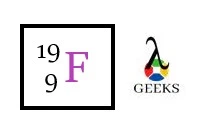Fluorine chemical properties are relevant facts to describe the chemical overview of Fluorine. Let us see briefly the definition of chemical properties below.
Fluorine chemical properties disclose the foremost fact that is Fluorine belongs to halogens. The halogen atoms are full of interesting chemistry that can be referred as the chemical properties. The chemical facts about Fluorine and its appearance as halogen are the key element of its chemical properties.
The chemical properties including melting point, boiling point, electronegativity, ionisation energises and others are main discussion point of this study. Each of the facts is going to elaborate throughout this article to make clear understandings regarding Fluorine.
Fluorine symbol
The symbol of Fluorine is F as per the initial of its name. As symbols are the short notation to identify chemical elements individually in periodic table the first letter of ‘Fluorine’ is used as it’s symbol.
Fluorine group in periodic table
Fluorine is placed at group 17. Groups are the column in periodic table where the elements are arranged by the ascending order of atomic number from top to bottom. Group 17 holds all the halogen elements vertically.
Fluorine period in periodic table
Fluorine belongs to second period in the periodic table. Periods are the rows in table where the elements are arranged with the descending order of atomic number from left to right.
Fluorine block in periodic table
Fluorine belongs to p-block in the periodic table, as its last atomic orbital is p. p-blocks are the part of periodic table where many elements with valance electron in p-orbitals are placed together.
Fluorine atomic number
Fluorine has been identified with an atomic number of 9. It means one atom of Fluorine holds 9 proton and 9 electrons.

Fluorine atomic Weight
The atomic weight of Fluorine is approximately 18.998 U. This is the slandered atomic weight for each atom of Fluorine in the periodic table, which refers to the weight of an imaginary hard sphere one F atom.
Fluorine Electronegativity according to Pauling
Electronegativity of Fluorine is 3.98. It has been found with the highest electronegativity among periodic element in Pauling scale. The 2p orbital in Fluorine atom has five electrons that means only one atom can give it a filled structure. Therefore, it becomes highly electronegative with electric urge.
Fluorine atomic Density
The atomic density of Fluorine atom is 1.696 g/L at STP. Atomic density is defined by the number of atoms in one litre or cm3 of an element.
Fluorine melting point
The melting point of Fluorine is −219.67 °C (53.48 K, −363.41 °F). It means the amount of temperature, which drives Fluorine to start changing its state from solid to liquid is very low.
Fluorine boiling point
The boiling point of Fluorine is −188.11 °C (85.03 K, −306.60 °F). It means the amount of temperature at which Fluorine starts changing its liquid state to vapour is also quite lower than others.
Fluorine Van der Waals radius
The van der Waals radius of Fluorine can be found as 147 pm.
Fluorine ionic/covalent radius
The covalent radius of Fluorine atom is 71 pm. Therefore, the distance between two atoms of Fluorine tend to make diatomic structure as F2 is 71 pm.
Fluorine isotopes
Isotopes are the type of atoms of one specific element where they differ from each other by the total number of nucleons present in centre. Let us identify isotopes of F.
The number known isotopes of Fluorine atom is 18 where 13F and19F is mostly found stable in natural circumstances. 19F isotope is the most stable one.
Fluorine electronic shell
Electronic shells are the spaces around the nucleus of an atom, where the electrons are noticed to be arranged by an attraction from centre. Let us find the electronic shell in F.
One Fluorine atom has 2 electronic shells. There the electrons are placed by 2, 7 arrangement.
Fluorine energy of first ionisation
The first ionisation energy of a single Fluorine atom is 1681 kJ/mol. First ionisation energy is defined, as amount of energy one atom needs to leave its last electron from the last shell.
Fluorine energy of second ionisation
The second ionisation energy of the Fluorine atom has been estimated as 3374 kJ/mol. This is the amount of energy, required by the F atoms to leave one electron from its +1 changed ion.
Fluorine energy of third ionisation
The amount of third ionisation energy requires for F2+ ion is 6147 kJ/mol. F2+ ion needs 6147 kJ of energy per molar mass to push an atom to leave one more electrons.
Fluorine oxidation states
The oxidation state of Fluorine atom is only −1, 0[6]. These oxidation states are actually the oxidation numbers that denotes the range of capability among F atom to accept or leave electrons from its natural state. Due to small size, F do not have tendency of leaving or accepting more than one electron.
Fluorine electron configurations
According to Aufbau principle, the electronic configuration of Fluorine atom is [He] 2s2 2p5. Helium is the respective noble gas of Fluorine that is placed at the same period with the element.
Fluorine CAS number
The CAS Identity number of Fluorine is 7782-41-4. CAS number is a registration number of the chemical elements assigned by Chemical Abstracts Service for unique verification of elements.
Fluorine ChemSpider ID
In ChemSpider database Fluorine has been given 4514530 numbers for verification. With the help of this number in ChemSpider database a unique verification of this chemical element can be done with free accessibility.
Fluorine allotropic forms
Allotropic forms of an atom are noticed to be different by structure with different external appearance as well. Let us find the allotropic forms or allotropes of Fluorine below.
The allotropic forms of Fluorine atoms are alpha and beta. Alpha Fluorine is opaque whereas Beta Fluorine appears as transparent atom.
Fluorine chemical classification
Fluorine appears as a diatomic atom with pale yellow colour. It is the lightest halogen in the series. Moreover, the elements are found to be very highly toxic by nature.
Fluorine state at room temperature
At room temperature, Fluorine is a gaseous element. By lowering pressure and temperature, it can be converted to liquid.
Is Fluorine paramagnetic?
Paramagnetic elements must possess unpaired electrons in the electronic arrangement. Let us find if Fluorine contains any unpaired electrons in its structure or not.
Fluorine is not paramagnetic. As it has no unpaired electrons in its atomic orbitals, it is clearly a diamagnetic element.
Conclusion
Fluorine is the element with lowest atomic radius in the periodic table. The toxic appearance of the element makes it unique. Moreover, the epic side of Fluorine is its high electronegativity, which makes the atom capable of making single bond with any other element easily.

Hi…..I am Sarnali Mukherjee, a graduate from the University of Calcutta. I love to teach and share knowledge on chemistry. I have gradually gained interest in article writing since one year ago. I would love to acquire more knowledge on my subject in the future.
Let’s connect through LinkedIn: